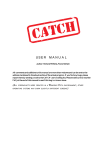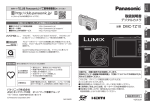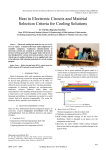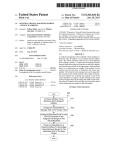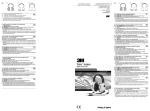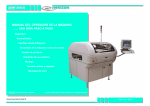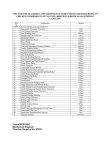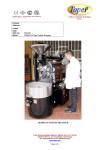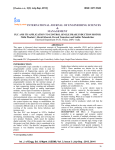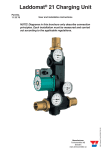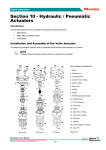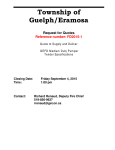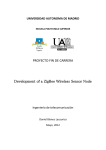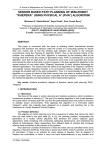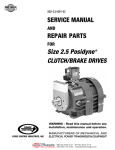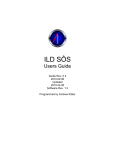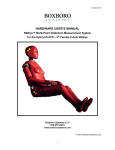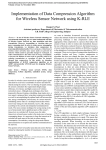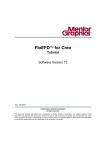Download "user manual"
Transcript
Int ern at ion al Jo u rna l of App lied R es ea rch 2 015 ; 1 (1 0): 25-29 ISSN Print: 2394-7500 ISSN Online: 2394-5869 Impact Factor: 5.2 IJAR 2015; 1(10): 25-29 www.allresearchjournal.com Received: 19-07-2015 Accepted: 21-08-2015 Er. Pal Riya Bipradas Sanchita ME Research Student [Power Devices], Dept. Of ETRX, PIIT Engineering College, Mumbai University, India. Hy510 Grease: Maximum Temperature Support and Its Application in Cob Led Heat Management Er. Pal Riya Bipradas Sanchita Abstract LEDs (high brightness, high power) applications are increasing exponentially every day. The life span of an LED depends on the semi-conductor material used as well as the current/heat relationship. The light output of the LED becomes weaker and weaker and once it reaches 50% of its initial value, the life expectancy of the LED has, by definition, been reached. A life span of a few hundred and up to 100,000 hours is possible, but only when avoiding high temperatures which drastically reduce the length of the LED’s life. High temperature not only results in reduction of life span but also causes surrounding temperature to rise, thus increasing the need for room air conditioning units. Currently there exist two cooling mechanisms for heavy COB LED structures. One is the use of heat sink of various designs and other is by using MCPCBs. Cooling of COB LEDs can also be done using simple cooling solution i.e. use of HY500 series of grease. Use of HY510 grease (which is actually a processor grease) is sufficient enough to provide good amount of cool mechanism for COB LEDs which has been proved through this research paper. This paper also proves that the level of heat flow efficiency increases when heat sink and processor grease HY510 are used together to cool COB LEDs. Keywords: Thermal conductivity (k), Thermal resistance (RTH), Metal Core Printed Circuit Board (MCPCB). High Intensity Discharge (HID), Chip-on-board (COB). Introduction Conventional light sources have always been able to release heat to the ambient through infrared radiation, and convection in the case of Fluorescent. This mode of heat transfer typically does not require advanced cooling methods to facilitate the process. LED sources however lose heat through conduction, which requires the additional knowledge of how to carry waste heat out of the LED efficiently in order to prevent system failure. An overview of the different modes of heat loss for various light sources can be seen in TABLE1. Table 1: Light Source Heat Loss Mode Comparison Light Source Incandescent Fluorescent HID LED Heat Loss % (Radiation) ~ 90 ~40 ~90 ~5 Heat Loss % (Convection) ~5 ~ 40 ~5 ~5 Heat Loss % (Conduction) ~5 ~ 20 ~5 > 90 Chip-on-board packaging enables plug and play benefits. In fact, packaging is now a key factor in the device’s total cost. The most prominent of these packaging types is chip-onboard (COB). With chip on board, several LEDs are mounted directly on the printed circuit board using wire bonds instead of pin connection type. Correspondence Er. Pal Riya Bipradas Sanchita ME Research Student [Power Devices], Dept. Of ETRX, PIIT Engineering College, Mumbai University, India. A. Cob Led Cooling Mechanism 1 (Existing Technology) Below figure1 depicts how a COB LEB cooling setup using copper lid (condenser), copper pad and MCPCB is utilized. The copper thermal pad of the chip package is directly soldered to MCPCB to provide low resistance path. Here 2 phase technique is used. “2Phase” in this case means the use of evaporation and condensation in order to dramatically increase the heat transfer characteristics of the device. Even though it provides efficient cooling, limitation that exist is that:- for cooling 1 LED which cost around Rs25/-, MCPCB ~ 25 ~ International Journal of Applied Research structure along with aluminum heat sink and copper pad are used which not only adds weight to this 1 LED but also increases the overall cost. Now if I want to glow more than 700 LEDs and MCPCB to hold 20LEBs cost around US $13 – 18 then think about the cost. And for 1LED setup (as in fig1) why to go for 2-phase type technique. 2-pase mechanism do not work well if LED module is placed 300 (i.e. in inclined position). 2 phase technology is only to be applied to cool devices or components when heat flux generated goes beyond 350W/m2. COB LEDs in application areas such as home, restaurants, hospitals, exhibition areas, schools and colleges, along streets etc. As per my experiment, the temperature of HY510 rises initially but comes to a constant value of 55 0C after 24 minutes of Operation (see TABLE 2). Table 2: Temperature Withstand By Hy510 Time (Minutes) Initial : 4 8 12 16 20 24 28 (final) Temperature Detail Of Hy510 (Oc) 34 43 48 54 55 55 55 The HY510 starts becoming thin at above 140 0C (see fig 3). Since, the saturation temperature of 3W COB LED remains nearly equal to 65 0C, applying HY510 is not limited only up to processors but can be very well applied for COB LED cooling of any type. Fig1: Cross Sectional View of Single COB LED Package Using MCPCB (FR-4) B. Cob Led Cooling Mechanism 2 (Existing Technology) Approximately 16%-20% of energy consumption comes from lighting; the LED market is pushing high demands on ecofriendly solutions. For this reason passive means are the prime methods to be considered to cool COB LEDs and modules. Figure 2 shows the use of heat sink stack having a core tube in which 2-phase cooling mechanism (active) happens. Heat sink stack continues to perform passive mechanism. However such systems (shown in figure2) have further drawbacks including, operating cost, reliability issues, performance degradation over time and its weight. Fig 3: The HY510 starts becoming thin at above 140 0C B. Test of Hy510: Cob Led Cooling Case 1: No Heat Sink and Hy510 Applied Figure 4 represents the experimental setup where T1 measures the temperature of Heat sink (for case 1 heat sink was removed) and T2 measures LED board temperature. Fig 2: LEDTM Module with Heat Exchanger II. All about Hy510 A. Experiment Done: Heat Handling Capacity of Hy510 There exist many series of HY Thermal Grease. HY500 series includes HY510, HY520, HY530, and HY550. All HY500 grease series are processor grease.HY510 has thermal conductivity 1.93 and thermal impedance as 0.225 and operating temperature up to 280 0C as per provided by HY-company manual. Its actual thermal conductivity and thermal resistance has been proved in part “IVCALCULATION” in this research paper. Actual thermal conductivity and thermal resistance value obtained is less than what it is mentioned in the user manual but even then HY510 is sufficient for providing cooling mechanism to Fig 4: Experimental setup When no HY510 as well as Heat sink is applied to COB LED, T2 displays very high temperature. This can not only damage the LED module but also increases the air temperature around it. Without applying any cooling solution, max saturated temperature zone reached by LED board is 63 0C that too for 3W module (shown in TABLE 3). Then how much saturated temperature it will be reached for +20W module? ~ 26 ~ International Journal of Applied Research Table 3: Temperature Reached By Cob Led Module Having No Applied Cooling Mechanism Time (min) 10 20 30 40 50 60 70 80 90 100 COB LED Board Temp T2 (oC) 32 46 49 53 58 61 62 63 63 63 Fig 5: Heat Sink + HY510 Case 2: Only Heat Sink Applied Placing heat sink at the base of the module will raise the heat conduction mechanism (TABLE 4 proves it). It serves better than case 1. Using HEAT SINK, COB LED Board Temperature dropped to 44 oC which marks saturated temperature for case 2 (check TABLE 3 and 4). Table 4: Temperature Reached By Cob Led Module (Heat Sink Applied) Time (min) Initial :10 20 30 40 50 60 70 80 90 Final: 100 LED Board Temp (oC) 32 34 35 38 40 41 44 44 44 44 Heat Sink Temp (oC) 32 41 45 47 48 49 49 49 49 49 When HY510 is applied, board’s heat is absorbed by both HY510 and the Heat Sink. Comparing TABLE 4 and TABLE 5 clearly proves it that there is a good reduction in the board’s temperature form 63 0C to 40 0C and a rise in Heat sink’s temperature from 49 oC to 50 oC. Rise in heat sink’s temperature is seen because the HY510 provides a good transfer path for the heat generated by the board towards the heat sink. Table 5: Temperature Reached By Cob Led Module (Heat Sink + Hy510 Applied) Room Temp(oC) 32 32 32 32 33 33 36 36 36 37 Heat Sink’s temperature rises along with time because of the fact that it performs cooling mechanism and keeps absorbing heat from the board. After certain time (here its 50 min), each and every point on heat sink receives uniform heat distribution. Thus static temperature of 49 oC is reached. Case 3: Heat Sink + Hy510 Applied Thermal Silver Grease HY510 is applied at the interface b/w COB board and Heat sink (Fig 5). Time (min) 10 20 30 40 50 60 70 80 90 100 COB LED Board’s Temp (oC) 30 33 34 35 37 40 40 40 40 40 Heat Sink’s Temp (oC) 37 44 47 48 49 49 50 50 50 50 LED Board’s temperature level is maintained at lower level by HY510. In short, HY510 has increased the heat conduction ability of the heat sink. See figure 6.Temperature of COB LED Board at the beginning reached a level of 63 0C without applying any cooling mechanism. This temperature is reduced to 44 0C by only heat sink and further more reduction is seen i.e. 40 0C by HY510 grease. Fig 6: Represents the plot of LED Board’s temp (green-case1, red- case 2 & blue- case 3) ~ 27 ~ International Journal of Applied Research III. Thermal Graph Figure 7 shows the actual image of 3W COB LED Module whose thermal imaging test has been performed. Fig 9: Represents The Thermal Images of LED Module (Heat _Sink+ HY510 Grease) IV. Calculations A. To Measure Thermal Conductivity of Hy510 Separation distance/length (between heat source & heat sink) = 10mm = 0.01m Q = 3 Watts T = 37 0C-300C = 7 0C = 280.150K ....... see from TABLE 5 Radius = 16mm = 0.016 m Area = πr2 = 3.14x 0.016 x 0.016 m2 Thus Thermal Conductivity “k” of HY510 = = . . Rth = Fig 7: Actual Image of 3W COB LED Module In Figure 8, 1ST represents the 3W LED when power supply was not turned ON. 2ND represents the image taken at 20min (TABLE 4), 3RD thermal view was taken at 40min and 4TH thermal record was captured at 90min. . . = . . . = 0.133 W/m_K = 0.07518 m2K/W A. Effectiveness (ϵ) Provided By Single Aluminium Fin See TABLE 5 readings. Assume that the entire fin has received uniform temperature distribution. i.e. T1= T2 = T3 = 37 0C (see fig 10). Rth (R) = Thermal resistance from fin to ambient. Rth (Ct) = Thermal resistance offered from heat source to fin root + by the aluminum material (see fig10) Fig 10: Resistance Model Fig 8: Represents the 4 Thermal behaviour of heat sink in 3W COB LED Thermal images 1, 2 and 3 given in figure 9 were taken when HY510 was applied b/w the LED circuit-on-chip plate and heat sink. 1ST represents the 3W LED when power supply was not turned ON. 2ND image was taken at time 20min, 3RD image at time 40min. HY510 proves very effective in thermal management. This can be proved by comparing the images 2 & 3 of figure number 9 (below) with 2 & 3 of figure number 8 (above). Air temperature measured was 28 0C and fin temperature as 370C T = 37 0C -28 0C = 9 0C = 282.150K Power (Q) = 3W Cross sectional area (A) of 1 fin = 1mm x 22mm = 0.001m x 0.022m Thermal conductivity ‘k’of aluminum = 229 W/m_0C ∆ Rth (R) = = = 3 0C/W Rth (Ct) = = Effectiveness (ϵ) = . . . = = 3.96 0C/W . = 1.32 Cooling Effectiveness provided by complete heat sink = (30 fins x 1.32) = 39.6% ~ 28 ~ International Journal of Applied Research V. Best Way to Apply Hy510 Do not apply HY510 directly to the base of COB Board. Always remember to wipe out the dirt with a dry cotton cloth. Second step is to apply HY510 to the base of the board where the heat sink is going to be screwed up. Now, I have tested (applied) this grease in 3 different styles. A glass slab of length x height x thickness = 126mm x 61.5mm x 5mm was applied as a source of pressure shown in figure 11. STYLE 3: Grease is applied in uneven form i.e. zigzag form. This technique too does not help the grease to evenly distribute itself (see fig 14). Fig14: Application of grease ‘STYLE 3’ Fig 11: Glass slab of length x height x thickness = 126mm x 61.5mm x 5mm STYLE 1: Grease is applied in the circular form/ dot form (Fig12). This style is highly recommended in majority of applications and also in my experimental test as it spreads itself uniformly. Fig12: Application of grease ‘STYLE 1’ STYLE 2: Grease is applied in vertical line or in horizontal line form. This technique does not help the grease to evenly distribute itself (see fig 13). VI. Conclusion Testing of HY510 Thermal Grease (processor grease) on COB LED 3W Module showed very good effective outcome. COB LED of 3W reached a saturation temperature zone of 65 0C with no cooling provision. Applying HY510 along with Al Heat sink reduced the temperature to 40 0C. Rule of thumb in thermal management says “For every 10 degrees Centigrade rise in temperature, the average reliability is decreased by 50 percent.” So in this research work, 25 0C reduction is achieved. Hence life span reliability remains unaffected on 3W COB LED Module when processor grease HY510 is used along with ‘Al’ heat sink. References 1. Er Pal Riya, Bipradas Sanchita. Heat in Electronic Circuits and Material Selection Criteria for Cooling Solutions, International Journal of Advanced Research in Electronics and Communication Engineering (IJARECE). 2015; (4):3. 2. Seri Lee. How To Select A Heat Sink, Advanced Thermal EngineeringAavid Thermal Technologies. 3. Angie Fan, Richar Bonner, Stephen Sharratt. An Innovative Passive Cooling Method for High Performance Light Emitting Diodes”, Advanced Cooling Technologies. Inc. 4. Yusuf Yasa, Ramazan Ayaz, Ali Durusu. Thermal Management of Power LED System, 3rd International Conference on Renewable Energy Research and Applications, Oct 2014. 5. Mehmet Kaya. Experimental Study on Active Cooling Systems Used for Thermal Management of High-Power Multichip Light-Emitting Diodes, the Scientific World Journal. 2014, 7. Fig13: Application of grease ‘STYLE 2’ ~ 29 ~






